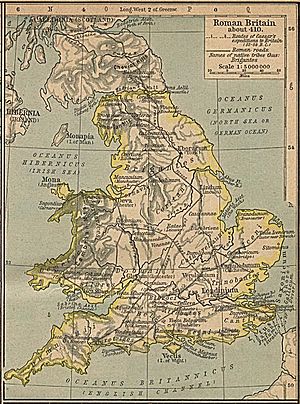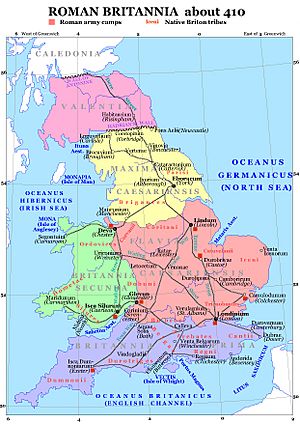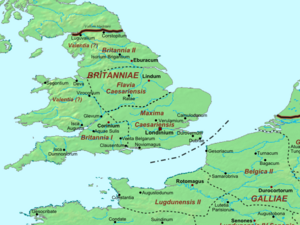Flavia Caesariensis facts for kids
Flavia Caesariensis was a Roman province in Roman Britain. Its name means "the province of Caesar Flavius". It was also sometimes called Britannia Flavia. This province was one of several new areas created in Britain around the end of the 3rd century. These changes were part of big reforms made by Emperor Diocletian.
Flavia Caesariensis was likely formed after the Roman general Constantius Chlorus defeated a rebel leader named Allectus in AD 296. It was listed as a Roman province around AD 312. The province was probably named after Constantius Chlorus's family, the Flavians. Its exact location and main city are still debated by historians today. Many experts think it was in the southern Pennines area. It might have even stretched to the Irish Sea and included the lands of the Iceni tribe. Some believe its capital city was Lindum Colonia (Lincoln).
Contents
How Roman Britain Was Organized
After the Romans conquered Britain, it was first managed as one large province. Its capital was first Camulodunum (Colchester) and then Londinium (London). Later, around the end of the 2nd century, this large province was split into two: Upper Britain (Britannia Superior) and Lower Britain (Britannia Inferior). Their capitals were Londinium and Eboracum (York).
Around AD 296, after Constantius Chlorus took back Britain from a rebel empire, more changes happened. Britain became part of a larger Roman area called the Praetorian prefecture of Gaul. This larger area was ruled from Gaul (modern-day France). Britain itself was then divided into several smaller provinces. These new provinces included Britannia Prima, Britannia Secunda, Maxima Caesariensis, and possibly Flavia Caesariensis and Valentia.
Where Was Flavia Caesariensis?
The exact locations and main cities of these late Roman provinces in Britain are not fully known. However, old Roman records show that the governor of Flavia Caesariensis was of "equestrian rank." This means they were a wealthy Roman citizen, but not a senator. This suggests that Flavia's capital was probably not Londinium, as Londinium was a very important city.
Some old documents, like a list of bishops from a meeting in AD 314, might give clues. Historians have tried to figure out which cities these bishops came from. Some think one bishop came from Lindum Colonia, suggesting it was a provincial capital. However, these ideas are just guesses and are not certain.
Different Ideas About Its Location
Over time, different historians have had various ideas about where Flavia Caesariensis was located.
- Gerald of Wales, a writer from the 12th century, thought Flavia was around London and reached into the area of Mercia.
- A famous book from the 18th century, The Description of Britain, also placed Flavia in central England. It said the province was bordered by the River Severn, the Thames, the North Sea, and the Humber and Mersey rivers. However, this book was later found to be a fake!
- Today, most experts believe that Londinium was part of Maxima Caesariensis, not Flavia.
- One historian, Eric Birley, suggested that Maxima and Flavia were once a single province called Britannia Caesariensis. This name might have been given to show favor for their support against the rebel Allectus.
- Birley also thought that the older province of Upper Britain was first split into two, then into three parts: Prima, Maxima, and Flavia. This idea is similar to an older theory by William Camden.
Some historians believe Flavia was created later than Maxima. They point out that the name "Flavia" might refer to other Roman emperors like Constantine the Great, Valentinian I, or Theodosius I, not just Constantius Chlorus. This means the province could have been named after any of them.
Images for kids






